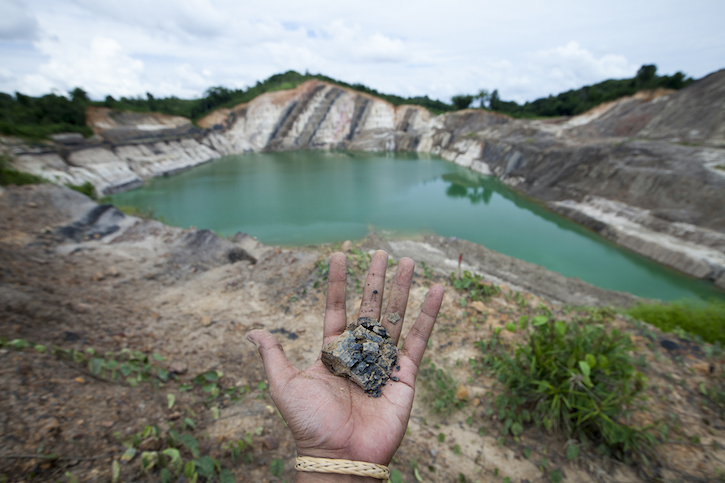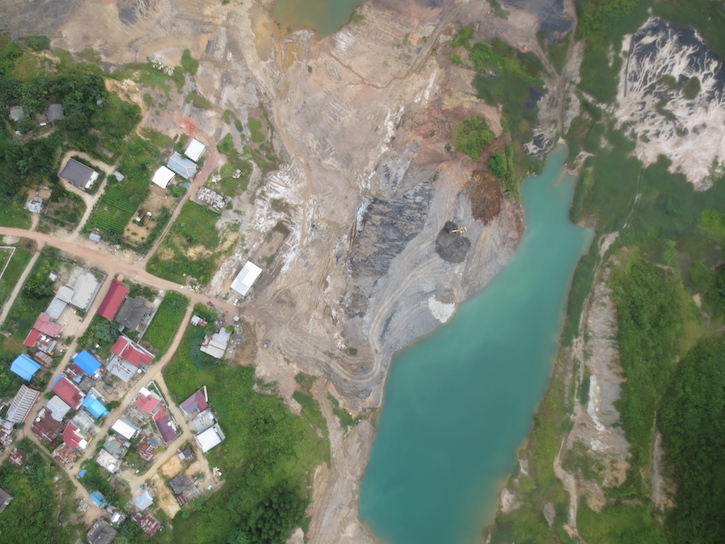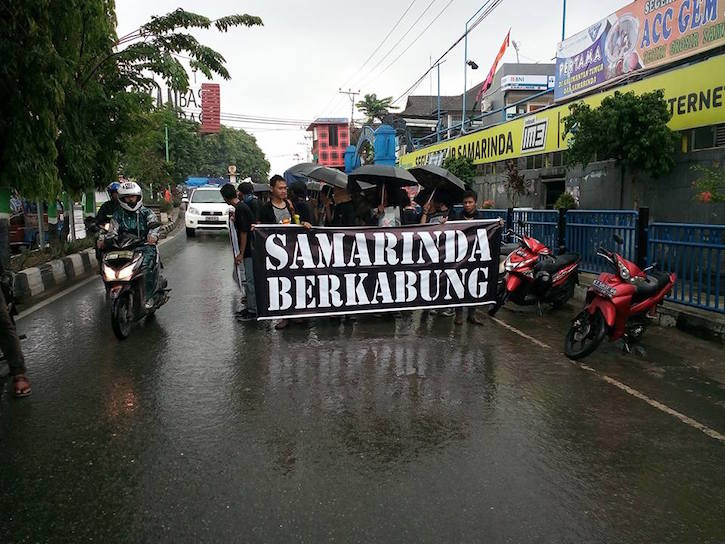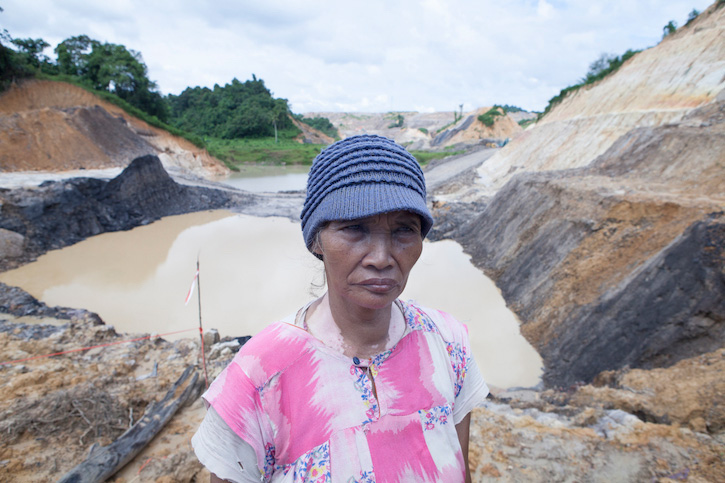The end of the boom has not meant an end to the perilous impact of coal mining in East Kalimantan
Tessa Toumbourou
On 23 March 2016 two high school students – Noval Slamat Riyadi, aged 16, and Diki Aditya Pratama, aged 15 – were found drowned in an abandoned mining pit in Kutai Kartanegara, East Kalimantan. The teenagers’ deaths bring to 22 the number of children that have drowned in unused, water-filled mining holes in East Kalimantan since 2011. Only three months prior, a 13-year-old, Aprilia Wulandari, was found drowned in a soccer field-sized mine pit on the outskirts of Samarinda, the regional capital of East Kalimantan. Aprilia was reportedly playing with friends on her way home from school when she fell into the unmarked pit.
One hundred-and-fifty such pits scar Samarinda’s landscape, with an estimated 500 in total across East Kalimantan, according to the regional branch of the Network for Mining Advocacy (JATAM). JATAM recently released a confronting YouTube film with interviews of the families who have lost children to mining pits.
Decentralisation laws, particularly the 2009 Minerals and Coal Mining Law, gave district and municipal administrations the authority to issue mining permits. As a result, mining has exploded across Indonesia. In East Kalimantan alone, nearly 50 per cent of the province is now covered in coal mining permits, threatening agricultural land and conservation areas. New powers for allowing district governments to issue permits did not, however, correspond with an increase in budget or capacity for local management and monitoring of mining operations or clean-up activities. The results are devastating.

The costs of a poorly monitored mining industry
Decentralisation and the global mining boom brought chaos to the industry. In many places multiple permits have been issued for the same land area, permits have been allocated illegally in conservation and protected forests and along water catchment areas, and there has been a huge loss of state revenue – official estimates suggest that up to half of Indonesia’s mining companies pay no royalties and are not registered to pay tax. A recent investigation by Indonesia’s Corruption Eradication Commission identified losses of almost US$1.24 billion in public revenue across Indonesia’s mining sector. Of a total of 10,827 mining permits issued across the country, 4563 were found to not meet ‘clean and clear’ standards, which include having a detailed environmental impact assessment and a post-mining reclamation and rehabilitation plan.
The proliferation of mining permits has had a damaging impact on people and the environment, particularly in Samarinda, where mining consumes 70 per cent of the municipality’s land area. Some mines are located within metres of homes and schools. While the industry brought employment and investment, it has also been the source of much angst –landslides and flooding worsened as a result of mining expansion in Samarinda according to JATAM’s research, with the World Wildlife Fund estimating the cost of the resulting damage at around $9 million.
Acids and sulphates from mining have leeched into rivers, contaminating local water catchment areas, fish ponds and wet rice fields according to local farmers in and around Samarinda who have experienced dramatic reductions in yields as a result.

With the boom in coal exports now over, many small and medium-sized mines have closed or remain inactive. But they continue to pose a serious threat to residents. The blue-green colour of the water-filled mine pits lures young people to them, who then misjudge the depth of the pits and the steep sides that make them difficult to escape. Furthermore, Greenpeace researcher Cut Hilda Meutia found that the pits contained high levels of chemicals, including magnesium, iron, aluminium, cadmium and arsenic. As the impact of ingesting or absorbing these chemicals is not immediate, the negative effects accumulate over time.
The community’s right to a clean environment
Civil society organisations (CSOs) have worked hard to push local administrations to clean up abandoned sites. For years, CSOs have advocated for improved management of mining in East Kalimantan, home to 28 per cent of Indonesia’s coal reserves. In 2013, after 11 people had drowned in disused mining pits in East Kalimantan, CSOs decided to pursue legal avenues. A case was submitted to the Samarinda High Court on 25 June 2013, beginning a year-long trial known as the Gerakan Samarinda Menggugat (Samarinda Citizen Lawsuit, GSM). Nineteen plaintiffs impacted by coal mining presented at the trial, including rice farmers and fishermen who claimed that their diminishing water supplies were increasingly acidic due to dust particles released by mining operations.
On 16 July 2014, judges ruled in favour of the plaintiffs, finding that the government had been negligent in fulfilling their obligations under the 2009 Environmental Law, which states, ‘Everyone shall be entitled to a proper and healthy environment as part of their human rights’. By not fulfilling this requirement, the court decided, the local government had denied the people of Samarinda their right to enjoy a clean and safe environment. The court also ordered the government to evaluate all coal mining permits in Samarinda, monitor reclamation and other post-mining efforts, and take action to protect community farming and fishing areas from contamination by coal mining activities. Yet, since then little has improved, and children continue to drown in exposed coal mining pits in Samarinda and in the neighbouring district of Kutai Kartenegara.
Shifting authority and shifting blame
NGOs believe one of the reasons for the sluggish response could be the recent reforms that have shifted authority over mining permits. The Regional Governance Law (Law No. 23/2014) introduced in October 2014 moves authority for coal and mineral mining (as well as forestry and fisheries) from district governments to provincial governments and the central government. Following a transition period, which should be completed by 2 October 2016, provincial governments will be responsible for issuing permits, and also for evaluating the status of problematic mining permits in their jurisdictions. Governors must report the results to the central government, which will decide whether to maintain or cancel the permits.
Muhammad Muhdar, lawyer and researcher at Samarinda-based NGO Prakarsa Borneo, explains that post-mining clean-up and pit closure is the responsibility of companies. District governments – until the introduction of the new law – were tasked with enforcing and overseeing this process. Yet despite the real dangers of leaving mine sites exposed, companies often evade their reclamation responsibilities. Laws require that companies set aside funds for reclamation activities before conducting extraction work, but in practice these obligations are often not met. ‘There are many companies that do not put aside reclamation funds, so the government doesn’t have the resources it needs to close mine sites,’ says Muhdar.
Frustrated with government inaction and excuses, CSOs have tried to find creative responses to the problem. ‘The government always gives the excuse that there is not enough funding for closing mines’, says Merah Johansyah of East Kalimantan JATAM. NGO activists have held actions following children’s deaths in local mining pits, asking fellow Indonesians to donate Rp.1000 to crowd-fund mine closures. ‘When the funds are collected, we’ll give the money to the government. So they won’t have any further excuses for inaction.’

Better late than never
East Kalimantan governor Awang Faroek Ishak has indicated his willingness to reform mining governance. Awang has a chequered past when it comes to the mining industry. During his time as district head of East Kutai, Awang was named by the Attorney General’s Office for embezzling state funds resulting from the sale of a portion of coal company PT Kaltim Prima Coal. But his recent attention to the industry’s problems is welcome, even if it comes late in the day.
In 2013 Awang issued a provincial moratorium on new concessions for mining, plantations and pulp and paper, which was restated in 2014. Awang has issued a statement saying that those companies on whose concessions mining-pit deaths have occurred must submit a mine closure plan and report on reparations paid to victims. Perhaps the most important reform has been the passing of a provincial regulation in 2015 enacting a supervisory commission. The commission will consist of government and civil society representatives tasked with overseeing mining reclamation and clean-up efforts, an important development that will introduce transparency and participation in the mining clean-up process, ensuring that pits are closed safely and in accordance with environmental standards.
An important step for improving mining governance in Indonesia will be ensuring that the shift in authority for mining permits from district to provincial governments does not slow down reforms. In the end it is the central government that should ensure there is no confusion over the division of responsibilities between the districts and the provinces.
President Joko Widodo, or Jokowi, was in East Kalimantan on 23 March 2016, when the bodies of teenagers Noval and Diki were found in mining pits. In response Jokowi has issued an audit of all mining permits issued in East Kalimantan. ‘I order the Ministry of Environment and Forestry and the Ministry of Energy and Mineral Resources to control and check mining [operations], especially small mining sites that don’t prioritise work safety,’ Jokowi told media in Balikpapan.
It seems momentum is finally gathering, and there is now an opportunity to tighten controls and mitigate further losses to human life, and to the ecosystems on which life is sustained. For this to happen, Jokowi needs to ensure that his demand for an audit of the mining sector results in real improvements in mining governance in East Kalimantan.
Tessa Toumbourou (t.toumbourou@student.unimelb.edu.au) is a PhD student at the University of Melbourne and has worked in Indonesia as an environmental governance researcher.












